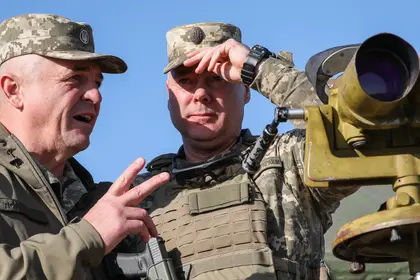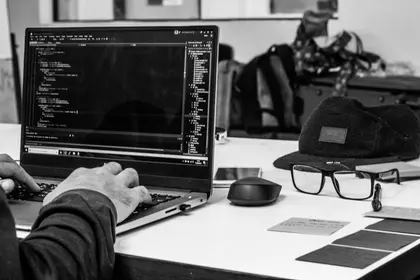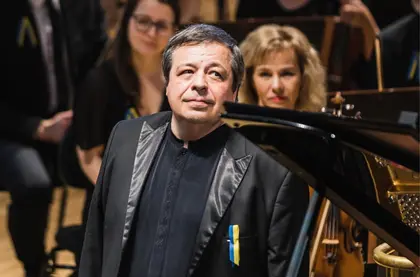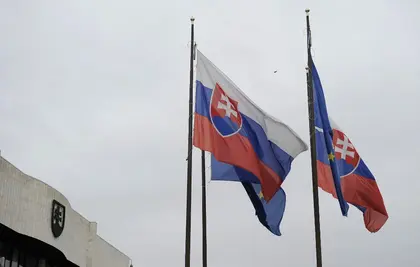Lieutenant General Serhiy Nayev, commander of Ukraine’s joint forces combatting Russian aggression in the country’s east, is convinced Moscow is readying for fresh attacks against Ukraine, but is confident that his forces will be able to counter any Russian actions.
The general invited the Kyiv Post to accompany him on a visit on Jan. 14, which, according to his aides, was typical of the hectic schedule for the man who controls Ukrainian forces on a line stretching from the port city of Mariupol on the Azov Sea to where Luhansk Oblast meets the Russian border.
The trip started at a large, heavily-guarded army base set back a few kilometers from the main road leading south from Konstantynovka in Donetsk Oblast. Fencing and barbed wire form an outer defensive ring, with its circumference scattered with tanks and armored personnel carriers concealed from air observation by white and black winter camouflage netting.
A road led past a concrete helicopter landing pad to the gates of an inner, walled compound, with a number of low buildings. This is one of Nayev’s communications and command posts, collecting information from the huge military zone of the country that he is responsible for.
Nayev sets off in his four-wheel drive. The driver is armed with a machine-gun and pistol, as is the soldier in the driver’s seat who wears a sophisticated radio headset built into his helmet and is the point of communications for anyone who needs to reach the general while he is on the move.
Slaloming through the snow
Two other vehicles, one in front and another behind, escort the general’s vehicle through the white steppe that stretches for kilometers in every direction, devoid of buildings and with only a few lonely trees.
Inside the vehicle, Nayev takes off his green army woolen cap to uncover close-cropped salt and pepper hair. Perhaps too many white hairs for someone only 48 years old and with a slightly boyish face.
Nayev, who was born in the town of Mohyliv Podilska in the Vinnytsia Oblast, has been a soldier all his life. “I always wanted to be in the military, even as a child,” he said. “I was attracted by a romantic sense of adventure. My father was in the military, and so it seemed a natural choice for me.”
He studied at a Moscow military academy in the dying days of the Soviet Union. When the union broke up in 1991, he was posted in what had been East Germany and took part in the withdrawal of Soviet forces from there. He said when Ukraine declared independence later that year he swiftly decided to join the new country’s army. He then studied at the National Defense University.
Nayev steadily moved up the ranks in a succession of jobs, and became acquainted with Western militaries on training spells in the United States and Britain. He said that like many other patriotically-minded officers he was disappointed that for many years the military was under-resourced and much of its best equipment was sold off, often illegally.
“Some people gave up and left the military. But I thought leaving was just taking the easy way out. I believed I had to stay on,” he said. Nayev said that as he attained more senior rank and commanded battalions and then brigades he always did his best to ensure that his men received proper training, and that every unit took part in realistic exercises.
The war starts
After Russia invaded and annexed Crimea and occupied a large swathe of the Donbas in 2014, Nayev commanded the Ukrainian military’s “Sector B” around Donetsk, which saw some of the most intense fighting, including at the city’s airport, where Ukrainian soldiers held out for months against a numerically far superior enemy.
As the war went on, Nayev assumed more senior roles, and last March Viktor Muzhenko, head of the general staff of Ukraine’s armed forces, appointed Nayev to his present position and as his deputy.
Nayev’s convoy arrives at the first of a series of battalion and brigade bases that Nayev is visiting today along the fringes of the conflict zone northwest of Donetsk, the largest Ukrainian city under Russian occupation.
The bases are in the basements of buildings on the outskirts of small towns, largely abandoned by those fleeing heavy fighting in 2014 and 2015. The walls of the basements are hung with large video screens displaying data and showing multiple images of different parts of the front, some of it via aerial reconnaissance, and all of it being monitored by intensely focused, mostly young, men.
At each post officers gather around Nayev and using large-scale maps, either on walls or laid out on desks, explain to him exactly what’s been happening in their area over the previous day.
“As much as possible I aim to keep an eye on everything. I think it’s important to keep close contact with my men, not just the officers, but the ordinary soldiers at the front lines,” Nayev said.
“I ask them whether there is anything they need, and, if there is something, I try to do what I can to see that they get it. I want them to speak to me openly. My style is not to criticize soldiers or junior officers during my visits,” he said. “If I notice something that needs dealing with, I discuss that later with the people in command and it is sorted out without recriminations.”
Key to success
Ukraine is vastly outnumbered by Russia’s forces, but Nayev said he is depending on intensive training to even up the odds. “As the commander of the joint forces I think my main strength is thorough preparation for defense,” he said.
“The main thing in all of this is the battle-readiness of the ordinary soldier – the person who, when it comes down to it, has to fight off the enemy, to shoot and kill him. Training is the key to each of them being able to perform their duty as has been envisaged. In the end everything depends on these people who are risking their lives for their country each day.”
Nayev said that he tries to visit places that have come under fire or have suffered casualties to meet with troops at their posts and to visit the wounded in hospital. “I spend most of my time here in my zone of responsibility, and whenever I’m not having to take part in meetings or conferences or dealing with delegations from Kyiv, I try to visit as many forward locations as possible.”
He spent the Christmas and New Year periods visiting his men at their various bases and posts. Nayev proudly said that his wife and three children joined him in the conflict area for the holidays.
Heading off to visit frontline trenches on the Horlivka front, everyone, including Nayev, dons flak jackets and helmets. The general has a semi-automatic pistol in a holster strapped to the front of his chest.
At a bunker protected by log walls and ceiling, which serves as the command post for this stretch of the some 400 kilometers of trenches along the front lines, the general is briefed by junior officers who tell him that there was a lot of gunfire in their general direction but not directly at them the previous evening. They did not fire back.
“They could have but they didn’t feel under a direct threat and they didn’t want to waste ammunition,” Nayev said approvingly.
Russia preparing to attack
Nayev said there have been key indications that the Russians are preparing a large attack on Ukraine.
“First is the way they have increased their troops in the area. For instance, where they had eight tactical battalions at bases near the Ukrainian-Russian border, they have now increased this to 12 in my zone of responsibility.
“They have also increased substantially the number of aircraft ready to operate from their airfields on their side of the border in the Donetsk area.”
More important evidence was that “Russian operational groups arrived in Donetsk and Luhansk Oblasts, something we knew from our ability to detect their satellite communications.”
Nayev said that a special type of satellite communications used by the most senior Russian officers had also been detected. The presence of regular Russian generals showed important arrangements and deployments were being made – likely in preparation for a major move.
“Their intelligence-gathering capabilities have increased threefold: more reconnaissance groups, radio-electronic groups, and human intelligence. All of these are standard measures that add up to preliminary actions before an attack.”
Nayev believes that the probability of a Russian attack has increased since the incident last November in the Kerch Strait, when Russian naval vessels attacked three Ukrainian ships trying to pass into the Azov Sea from the Black Sea. The Russians captured the Ukrainian vessels, wounding three Ukrainian sailors and taking all 24 crew prisoner.
Nayev thinks the incident is part of a Russian plan to take control of Ukraine’s Azov Coast and to create a land corridor westward from the territory Moscow occupies, through Mariupol and on to Crimea. He warns that recent Kremlin propaganda claiming that Ukraine wants to use chemical weapons against Donetsk is aimed at creating a pretext to justify such a Russian attack.
Learning from harsh lessons
Nayev said that Ukraine’s harsh experiences in 2014 and 2015, when regular Russian forces inflicted heavy casualties on a then relatively poorly-prepared Ukrainian military, had shown the urgent need to hone the abilities of tank and artillery forces. He said this had been accomplished.
He said America’s provision last year of cutting edge, man-portable Javelin anti-armor missiles, had beefed up Ukraine’s own home-manufactured capacity of Stuhna and Corsair missiles.
He said that all the territory under his command has been mapped out using sophisticated satellite and electronic technology, some of it furnished by the U.S., so that precision artillery and missile strikes can be called in to destroy enemy armor within a very short time.
“All the electronic resources are combined in a unified system that means we not only have the ability to identify the enemy’s location, but the relevant artillery units get the coordinates at the same time,” Nayev said. “So where in the past a response to hit back took tens of minutes, each artillery piece now has their position within a few minutes.”
He said that air defenses in the joint operations area have been reinforced, and said “by any calculations, if the Russian Federation tried to use its air force against, us they would sustain such losses that its pilots would refuse to fly sorties here.”
He said that although he has forces with specialized training in urban warfare, should Russian forces enter Mariupol, the priority is not to allow them to do so.
“Our task is not to allow the battle to come into the city,” he said. “You saw that our forces are positioned at a distance away from Mariupol – our defenses are on the approaches to the city. But wherever they attack, we will defend every piece of our territory and we have the ability to do that in a devastating way.”
Hearts, minds and chocolate
On the way to the front line town of Andriivka, one of the places that features regularly in the bulletins recording outbursts of violence, Nayev says Ukrainian troops have managed to squeeze Russian forces further away from the town, toward Donetsk just a few kilometers away. Many inhabitants who fled in 2014 have now returned he said.
Nayev believes that promoting a sense of safety and the return of normality is an important part of the military’s job.
“We need to show that we’re making progress in the war. There is a lot of Russian propaganda on television and radio against us, and the army needs to dispel any intimidation that people might feel, he said.
Nayev, himself keen on music and theater, encourages efforts by the army to reach out to civilians by putting on cultural events.
Entering the town by a road that two years ago was off limits because it was so close to the pro-Russian forces’ positions, we arrive at a school. Nayev and the servicemen accompanying him stow away their weapons and enter the building, where some 400 children are watching a light-hearted play being performed on the school’s stage by a theater troupe sponsored by the army.
At the end of the show, the general invites the children into a side room and leads the way in distributing hundreds of bars of chocolate. “Sometimes I distribute ammunition and medals, and sometimes chocolate,” Nayev said.
It’s difficult to tell who is most delighted – he or the children.
You can also highlight the text and press Ctrl + Enter







Comments (0)